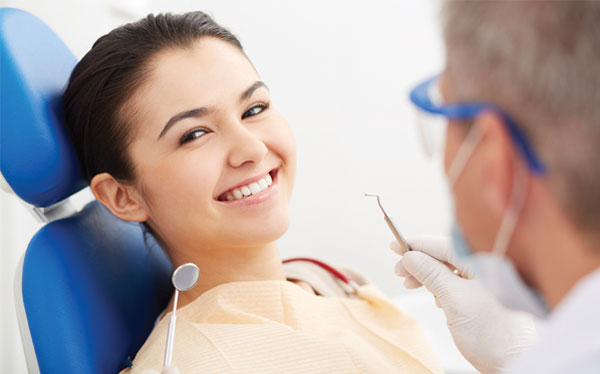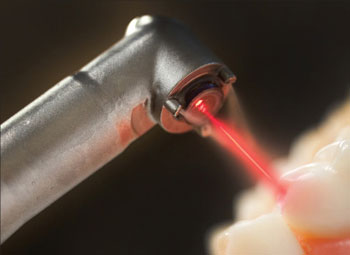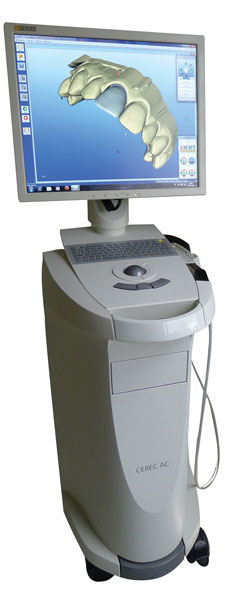Bringing technology to teeth
 Going to the dentist doesn’t have to be scary. While it may not be a person’s favorite appointment to make, technology has made the experience effective, efficient and enjoyable while allowing patients the access they need to dental services.
Going to the dentist doesn’t have to be scary. While it may not be a person’s favorite appointment to make, technology has made the experience effective, efficient and enjoyable while allowing patients the access they need to dental services.
“The standard of care in dentistry keeps changing,” admits Dr. Elissa Edwards with Elite Smiles Dental in Appleton. She adds that technology is becoming the norm, but she’s still trying to figure out what options fit best into her practice after graduating in 2010.
“You could go crazy with technology as a dentist, but if it’s not going to help the patient, there’s really no point,” shares Edwards.
While she wants to open the dialogue and be able to effectively answer patient questions, she doesn’t want to overwhelm them either. Edwards says getting to know the patient and earning their trust is most important to her as it is to other area dentists who say the patients come first.
“I get so many hugs in a week where people say, ‘That wasn’t so bad,’” she adds.
Digital X-rays are just one step in making dental visits easier.
“They’re a lot quicker than traditional film and less radiation,” explains Dr. Jessica Pasono, a general dentist with Smiles on Calumet in Appleton.
X-rays of the past involved a chemical print process to develop the film, notes Dr. Douglas Nelson of Appleton. Now, however, they provide a bigger picture, both exposure and effects can be altered and they show a 3-D image from the head to the neck, which provides a much clearer view. A series of photos can be taken from different viewpoints that allow dentists to go through the images a millimeter at a time. The technology also allows for the mapping of nerves and a roadmap of sorts as to where the sinuses lie, Nelson explains.

Lasers are helpful in dentistry as well because they can aid in better tissue response, stop cold sore growth, minimize canker sores, trim tissue and stop bleeding, according to area dental professionals.
Cone beam imaging is also something Edwards has been using in her practice.
“It takes all the guess work out of things so you’re also more prepared,” she says, along with focusing the appointment and patient time.
Nelson notes that the 3-D technology is helpful in finding an abscess tooth and placing implants. The angles, depth and everything about how the implant is placed can be predetermined, Nelson says, adding that he sends the information to a lab in Germany who sends a milled guide back to him to be used during the procedure.
“By using the guide, you don’t make the mistake of hitting where the tooth was,” Nelson shares. Implants are made from titanium and come in varying lengths and sizes. Titanium is now the preferred material for implants because studies have shown that bone will grow to the titanium and the implant becomes part of the bone.
Intraoral cameras also aid in taking photos of teeth. A camera, which looks like a wand, is hooked up to a computer and monitors allow patients to see what dentists are seeing at the same time, along with providing enhanced visibility of teeth in question.
“No. 1 is being able to educate the patient and having them understand what’s going on in their mouth,” says Pasono. “When you pop a film, it’s right up on the screen.”
Barnes & Associates Dentistry in Appleton also makes use of intraoral cameras.
“It’s so helpful for patients to see a photo of a tooth with a crack,” explains Ann Deeg, registered dental hygienist. Being able to display the image versus trying to find the right angle with a handheld mirror makes better views possible.
Barnes & Associates Dentistry aims to keep as many services under one roof as possible.
“It allows us to offer patient services that they’d have to go elsewhere for,” Deeg says. “In 18 years working here, I’ve had so many people say to me that I like that I don’t have to go to 10 other places.”
Another means of technology that is helping with the early detection of dental issues and being used as a screening device is Velscope.
Pasono describes the “safe blue light” as being able to illuminate the oral cavity. Regular tissue will appear green — somewhat like the look of night vision googles — while abnormal tissue will have a black hue under the light.
“It helps to see things the naked eye can’t,” she shares. Since trauma or a burn within the mouth also could appear dark initially, Pasono typically waits two weeks before referring patients for further testing.
Pasono suggests using the Velscope once a year on patients over the age 18, depending on other risk factors.
A cavity detecting UV light technology is used in Edwards’ office during hygiene appointments.
“It’s so crazy accurate. It helps me going into the next appointment,” she says.
DIAGNOdent is a laser that emits a safe light that’s being utilized to help with cavity detection. The hand-held wand is calibrated to each patient first and then emits different wave lengths depending upon how deep a cavity goes. It also will make a noise if the reading is high. According to Pasono, mostly back teeth are of concern.
Thanks to technology, Nelson also is able to save patients time if they need crowns. He has been using the CEREC AC technology since 1998. The system allows for imposing an image of a new crown on a prepped area to see what it will look like on each patient. Once in place, Nelson is then ready to mill the crown onsite.
The crown begins as a block of porcelain that appears purple in color. The actual color is selected from a shade guide. Once the milled crown is ready, it is tested for fit, then cooked at 1300 degrees and changes color to the selected shade that matches the patient’s teeth.
“We’ve got a couple of guides. It’s sort of like picking paint,” Nelson says, adding that a crown color can be customized within a degree and accents can be painted on.
CEREC AC also is used in planning bridges and orthodontics.
There is no longer the need for a temporary crown and no two-week wait because it’s all done the same day within a 21⁄2-hour period.
Lasers are helpful in dentistry as well because they can aid in better tissue response, stop cold sore growth, minimize canker sores, trim tissue and stop bleeding, according to area dental professionals. Amalgam or “silver” fillings also are becoming a thing of the past. Not only are composite fillings more cosmetically pleasing, they are safer with no mercury. Amalgam fillings need to be deposited correctly, Deeg notes. Amalgam fillings require the removal of more tooth structure, tend to expand over time and cracks could lead to the need for crowns. Composite fillings only require conservative prep and bond to the tooth’s surface.
In addition to gadgets, strides also have been made in patient comfort through the use of sedation whether it be through pills taken prior to an appointment or the use of nitrous oxide, otherwise known as “laughing gas.”
“They’re sedate through the whole appointment. They’re not out, we can talk to them and they can talk to us,” explains Nelson. “It’s probably the thing that brings most people in.”
Barnes & Associates Dentistry also offers nitrous oxide to patients at any procedure at no cost.
“If it helps make their visit more enjoyable, that’s what we’re here for,” Deeg says. “We want it to be that very comfortable feeling.”
As Nelson notes, some individuals have had traumatic experiences that keep them away from dental visits.
“We try to communicate with people here that they’re important to us,” Nelson says. “A lot of times once they see it doesn’t have to be traumatic, they do a lot better.”
“It shouldn’t be that way, we don’t want it to be that way and we’re out to change that phobia,” adds Deeg who notes patients return because there are familiar faces at Barnes & Associates Dentistry.
While area dentists agree that they don’t want their practices to be confused with spas, other things found in their offices include massage chairs, music through iPods and views of nature. With the windows from patient rooms at Barnes & Associates facing the woods, it’s not unlikely to see turkeys wander by.
Paperless record systems also are aiding dentists. Having access to health history, testing and previous visit notes allow for time saving and accuracy while eliminating clutter.
The use of radio systems go a long way with communication as well.
“It helps us to know where the team needs to go,” says Pasono of the “good extra.” “It helps us be in good communication with one another.”
While Pasono is still new as a dentist after graduating in 2014 from Marquette University, she shares that she’s learned through technology and continues to stay abreast of changes through continuing education.
“There’s so much you can learn and benefit from,” she says.
“Patients want to know that they’re not seeing someone who is out of date,” adds Nelson who keeps up with journals, courses and webinars as well.
—FC











Leave a Comment